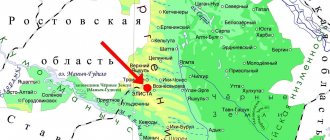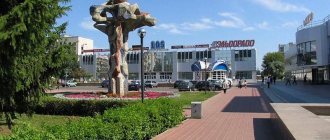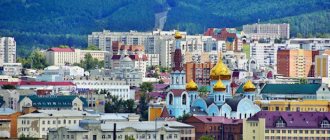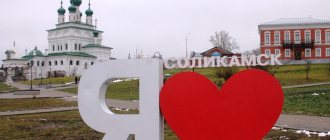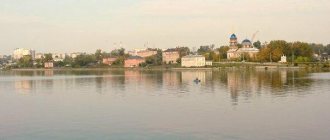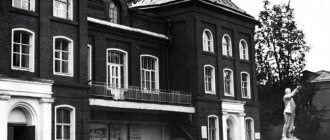Lipetsk region, Zadonsk
Founded by two elders-schemamonks, Cyril and Gerasim, natives of the Moscow Sretensky Monastery, who brought around 1610 a copy of the Vladimir Icon of the Mother of God, which later became famous as a miraculous one. The monastery contains the relics of St. Tikhon of Zadonsk, to which people flock from all over Russia to venerate them. In 1692, a fire destroyed all the buildings of the monastery. Only the shrine remained unharmed - the icon of the Mother of God. In 1697 the monastery was restored. At the beginning of the 19th century, the entire monastery was rebuilt.
In 1845-1853, according to the design of the architect K. A. Ton (author of the Cathedral of Christ the Savior in Moscow), a new majestic five-domed cathedral was built in honor of the Vladimir Icon of the Mother of God. During the construction of this temple and the dismantling of the old one in 1846, the incorruptible relics of St. Tikhon were discovered. On August 13, 1861, his glorification took place. Many grace-filled healings took place at the relics of the saint.
By the beginning of the 20th century, the Zadonsk Monastery was a whole town, consisting of 6 churches, a bell tower, a hospitality house, a hospital, a pharmacy, two brick factories, one candle factory, and a parish school. The brethren of the monastery numbered about 300 people.
In the 70-80s of the 20th century, a canning factory was located on the territory of the monastery, in all its buildings, and the cathedral itself was converted into a warehouse for products.
In 1990, Vladimir Cathedral and part of the monastery buildings were returned to the Russian Orthodox Church.
The monastery receives pilgrims and operates a number of free pilgrimage hotels.
Tourist portal of the Lipetsk region https://www.liptur.ru/
Znamensky Women's Monastery in Yelets
Lipetsk region, Yelets
The convent was founded in 1683. on the site of the skete of the Trinity Monastery in the Kamennaya Gora tract, where, according to legend, in the 14th century. there was a city. In 1764 - abolished, restored in 1822. To the beginning XX century crowded. The territory was surrounded by a fence with towers (1820s) and a multi-tiered bell tower (1840s - 1861). After the revolution, it was transformed into an artel, finally closed in 1929, the buildings are occupied for housing. In the 1970s and 80s, the buildings were mostly abandoned. Restoration began at the end. 1990s, reopened in 2004. There are 2 temples on the territory of the convent. The two-story church in honor of the Sign of the Mother of God was built in 1813. On March 14, 1929, the plenum of the Yelets City Council unanimously decided to close the Znamensky Monastery and transfer its buildings to cultural and educational purposes. The monastery church was closed on May 2, 1929. In 1937, the process of destruction of the temple began. In 1997, the complex of monastic buildings was transferred to the Russian Orthodox Church represented by the community of the Ascension Cathedral in the city of Yelets. In 2005, the restoration of the Znamensky Cathedral began based on drawings found in the archives. In December 2008, the restored temple was consecrated. In the spring of 2006, according to the design of architect A.V. Novoseltsev, in the ancient part of the monastery, where the St. Nicholas Church stood before the fire of 1769, a wooden church was founded in the name of St. Nicholas the Wonderworker. It was built in one construction season and consecrated by Bishop Nikon on December 31 of the same year. A. Novoseltsev conceived the temple in the traditions of old Russian wooden architecture, since now no one can say exactly what the old St. Nicholas Church looked like. The frame for the temple was cut in Chaplygin, the dome was made at a specialized enterprise in Volgodonsk, the tent and other wooden work were made by craftsmen from Moscow. The rite of consecration and the first liturgy in the new church were served by Bishop Nikon of Lipetsk and Yelets.
Temples and monasteries in Yelets
The history of the Yeletsky Trinity Monastery can be divided into two periods. During the first of them - from 1592 to 1775 - the ancient monastery was located on a high cape on the right bank of the river. Elchik, at its confluence with the river. Pine. After its abolition during the reign of Empress Catherine II, the monastery was rebuilt in 1836 in a new location - on the western outskirts of Yelets, behind the outpost, on the Oryol road - where it existed until its closure, which followed shortly after the revolution.in 1919, the Trinity Monastery was closed, and part of its premises were transferred to the proletarian commune. The question of creating a commune was raised as early as January 15, 1919, but it was created no later than March, after the “Bulletin of the Poor” in February 1919 suggested that “nationalized monasteries with model farms should be transferred to Soviet farms.” In connection with the creation of the first proletarian commune on the basis of the monastery, the inhabitants of the Trinity Monastery were pushed out, and then conflicts began, provoked by the “builders of a bright future.”
One of the last solemn church services on the occasion of the patronal feast took place in the monastery on the day of the Holy Trinity on June 13, 1919. At the same time, at their meeting, the communards of the 1st branch of the Yeletsk proletarian agricultural commune unanimously “decided to petition the department. ext. management and the Council of Deputies on the temporary closure" of the monastery church.
By the summer of 1922, the residents of Yeltsov lost the opportunity not only to bury their loved ones in the revered monastery graveyard, but also simply to visit holy graves - according to the Rostovtsevs, “everything there is distorted.”
In subsequent years, there was a gradual destruction of the monastery churches and other buildings, as eloquently evidenced by the decision of the Yelets authorities to satisfy the petition of the commune to build a dairy farm and barnyard from the remaining bricks from the destroyed church of the former monastery.
After the war, the surviving buildings of the former Trinity Monastery belonged to the commune of the Rodina branch of the Yeletsky state farm, and on June 27, 1963, the building of the Tikhvin Church, which was in disrepair, was transferred from the balance of the Yeletsky state farm to the balance of the Yeletsky city council.
On October 18, 1963, by decision of the Lipetsk Regional Executive Committee No. 766-686, all monastery buildings with a total book value of 25,758 rubles. were transferred to the Yeletsstroy trust: residential building (calf barn) - 2311 rubles; warehouse (former church) - 6878 rubles; vegetable storage - 492 rubles; warehouse (former bakery) - 1288 rubles; basement under the bakery - 63 rubles; basement under the forge - 90 rubles; basement under the church - 388 rubles; water tower (bell tower - author's note) - 3045 rubles; fence of the former monastery - 8250 rubles; garage in a fence - 1975 rubles; forge - 978 rub.
Soon after this, the two main churches of the Trinity Monastery were finally destroyed - in 1965 the Trinity Cathedral was blown up, and in 1969 the Tikhvin Church was de-roofed and blown up.
In recent years, the territory of the monastery was occupied by motor depot No. 4, and apartments were built in the fraternal building and the Panteleimon Church attached to it.
Znamensky TEMPLE IN VESHALOVKA
Lipetsk region, Veshalovka
The warm stone church of the Icon of the Mother of God in the “pseudo-Gothic” style was founded in 1768 by the owner of the Guards estate, captain Yakov Afanasyevich Tatishchev (1725-1806). The church was built and consecrated in 1794. According to the church, the village was called Znamensky.
The author of the project was the then young architect Vasily Ivanovich Bazhenov (1737-1799), although a number of researchers question the authorship. The church is made of red brick and richly decorated with white stone elements. Initially, the bell tower stood separately, but then it was connected to the main building.
During the years of Soviet power, since 1932, the temple was not operational. Repair work began in 1987, the temple reopened only in 2003. While restoring the architectural monument, specialists also took care of the surrounding area - they made a new fence, paths and updated the landscaping.
When visiting the Znamensky Church, tourists are often interested in the fate of the Tatishchev estate next door. Unfortunately, all that remains of it is a beautiful turret and the ruins of a chapel with a family tomb.
And so that at least one dome with a cross can be seen from every point in the city. The merchants agreed to these conditions, and construction began. When 31 churches had already been built, the revolution broke out. The last two temples were never built. Whether the legend is true or not is not known for sure. However, today, of the supposed 31 temples in Yelets, only 13 have survived, some of which have survived to this day in the form of ruins.
Let's walk along the streets of the ancient city and look at these ancient buildings.
Ascension Cathedral
The main cathedral of the city is the Ascension Cathedral. Already on the approach to this majestic structure, you begin to understand why. Local residents consider it the third largest in the country after the Cathedral of Christ the Savior in Moscow and St. Isaac's Cathedral in St. Petersburg, which is exactly how it was intended. Maybe this was once the case, but now dozens of such huge temples have been built.
But let's return to the Ascension Cathedral.
The cathedral took 44 years to build according to the design of the famous architect Konstantin Ton, the same one who at one time designed the Cathedral of Christ the Savior. Do you find some similarity in the monumentality of both cathedrals?
In the past, on Red Square, next to the Ascension Cathedral, there was another temple - the Resurrection Church. But it did not please the Soviet authorities and was destroyed in 1931. Later, Red Square was completely leveled. Thus, the last traces were erased, reminding the residents of Yerevan of their “old cathedral” - one of the most beloved churches in the city.
Today you can only look at the remains of its foundation, discovered by archaeologists in 1996.
Transfiguration Church
The Transfiguration Church was built in 1771, modeled after the Church of St. John the Warrior in Moscow.
The background of the temple is as follows: the once wooden Transfiguration Church replaced the ancient Pyatnitskaya Church. But after a while it stopped accommodating all the parishioners, and wood is a short-lived material. Therefore, in 1761 it was decided to build a new stone church. 10 years later, the new temple opened its doors to believers in Yerevan.
Years passed, the temple was rebuilt several times: a chapel in honor of John the Baptist was added, the altar was rebuilt, the refectory was expanded...
Today, the Transfiguration Church has been completely restored.
Church of the Nativity
The wooden Church of the Nativity of Christ was first mentioned in scribe books in 1628-1629. At that time it was one of the smallest churches in the city.
At the turn of the 17th and 18th centuries, instead of the old wooden church that had fallen into disrepair, a new one was built, but also made of wood. Fortunately, there were a lot of forests in the area.
But the new temple did not stand for long; several decades later it burned down in a fire. In 1960, the villagers again built a temple, again a wooden one. But then they realized that they needed a larger church, because the old one could no longer accommodate all the parishioners.
In 1772, the construction of the stone temple was completed. They built it in a hurry, since the former wooden Nativity Church again... burned down in a fire.
But the long history of the Nativity Church does not end there. The haste of construction affected the quality of the new structure. Why, in the mid-19th century, a decision was made to build a new temple. There was absolutely not enough money, but after a few years the construction was completed.
The main chapel was consecrated in the name of the Savior, the Image Not Made by Hands, and the former main altar in honor of the Nativity of Christ now became a chapel.
The main attraction and shrine of the Spasovsky (no, I was not mistaken with the name, because after perestroika the temple was consecrated in the name of the Savior Not Made by Hands, as I wrote above) of the temple was the miraculous Tikhvin Icon of the Mother of God, revered since 1761 by the residents of Yelets and neighboring counties.
After the revolution of 1917, the Spasovskaya Church shared the fate of most Yelets churches: artistic and historical values were confiscated from it, chapters were demolished, and storage facilities were placed within its walls.
Today the Church of the Nativity is in very good condition.
Church of St. Michael the Archangel
The once wooden church, consecrated in honor of Michael the Archangel, was built at the beginning of the 16th century on Red Square.
A little later, at the beginning of the 18th century, the temple was rebuilt in stone and wood. But in 1722 it was decided to call the Archangel Church on Red Square the Resurrection Church.
The Church of St. Michael the Archangel appeared on the present site at the end of the 18th century.
In 1822, the church building, built to the vaults, collapsed. I had to start almost all over again. The appearance of the temple has undergone some changes. This is how the Archangel Church took on its real appearance.
Today, the Archangel Church is being restored little by little, although full-scale work is still a long way off. But let’s hope that this temple still has a long and bright history ahead.
Church of the Assumption of the Blessed Virgin Mary
An outstanding monument of temple architecture of the 18th century. The Assumption Church was built in honor of the victory of the Russian people in the War of 1812. Initially, the Assumption Church stood on Red Square. When the townspeople started thinking about building a new cathedral on the square, they began to choose where to move the Assumption Church? Finally, the location was chosen, and the foundation stone of the new Assumption Church took place “behind Khlebnaya Square” at the corner of Voronezhskaya and Uspenskaya streets (now Marx and Sovetskaya).
The construction of the temple was completed in 1892. A little later, a 79-meter, three-tier bell tower rose nearby. Built in the best traditions of Russian classicism, it is to this day the architectural structure of Yelets that is unsurpassed in height.
Today, the unique Assumption Church is under restoration. It is hoped that in a couple of years it will appear before the townspeople and guests of the city in all its splendor.
Temple of the Yelets Icon of the Mother of God
The construction of the temple on Luchkovskaya Square was envisaged back in 1827, but construction began only at the very end of the 19th century.
As a result, the built church has no analogues in Yelets. November 26, 1915 became the birthday of the last Orthodox church built in Yelets.
The temple was built on the occasion of the 500th anniversary of the battle with the troops of Tamerlane. According to one of the legends, it was he who was helped to overcome by the image of the Mother of God, who appeared to the khan and drove him away from the Russian lands.
After the revolution of 1917, the Church of the Yelets Icon of the Mother of God faced the fate of all Yelets churches. Before the war 1941 - 1945 a granary was located within its walls. After the war, the roofless temple fell into disrepair, the cornices were destroyed, and the plaster was crumbling.
The temple was restored only in 1995. It was in 1995, during the celebrations dedicated to the 600th anniversary of the miraculous deliverance of Rus' from the invasion of Tamerlane’s troops, that a religious procession took place.
Today, the Church of the Yeletskaya Mother of God is the dominant feature and decoration of the southern district of the city.
Amazing Grand Ducal Church
The Grand Duke's Church is one of the most unique in architecture and beautiful in Yelets.
The construction of the temple was dedicated to the memory of Alexander II.
As you know, on March 1, 1881, the emperor was villainously killed. In memory of him, churches began to be built throughout Russia. So in Yelets in 1883 a small chapel was built. A little later a temple was added to the chapel.
Construction was completed in 1911 and the temple was consecrated on February 11 to mark the 50th anniversary of the Tsar’s manifesto on the abolition of serfdom.
The author of the idea of building the temple and its sponsor was the local merchant N.A. Zausailov. He favored the princely family so much that he was going to pave the floor of the temple with gold plates. With this he turned to Nicholas II, to which he replied: “Then put the plates on edge!” Naturally, the merchant could not afford such a solution. This idea had to be abandoned, but another idea was still implemented. The main dome of the temple is crowned with a cross made of pure crystal in a gold frame. During the daytime it shimmers beautifully in the sun, and in the evening it is illuminated by lamps. To ensure that the cross was always clean, a copper tube with holes was laid next to it, from which water flowed and washed it.
There is a legend that the original cross, now adorning the top of the temple, was saved by local residents during Soviet times. They kept it in a hidden place for a long time and only after many years they removed it and reinstalled it in place.
But there is another version, which says that the cross now installed is just a copy, and the original was destroyed by the communists.
The interior design of the temple is no less fascinating. Bright majolica panels, a luxurious iconostasis, and the walls... they seem to be covered with mother-of-pearl scales.
In 1913, a charity house was built next to the church to mark the 300th anniversary of the Romanov dynasty. It was intended to accommodate the elderly, sick and disabled. At the same time, they began to build a cave temple in the name of St. Nicholas the Wonderworker.
The walls of the charity house are decorated with a majolica panel; the authorship of this masterpiece is attributed to Vasily Vasnetsov.
At the top you can see an inscription telling about the history of the building and its purpose. In Soviet times, the inscription was destroyed, but in our time it has been restored using surviving photographs.
And on the side you can see a monumental panel depicting an ancient Russian city.
Currently, the Grand Ducal Temple is a decoration of the city and attracts thousands of city guests to admire it.
Church of the Intercession
The Church of the Intercession was one of the first stone churches in the city. It was erected in the mid-18th century to replace an old wooden church. At the same time, a high bell tower was built next to the temple.
In the mid-19th century, the need for repair work on the Church of the Intercession became obvious, since cracks in its walls had long been noticeable. After removing the iconostasis, the most significant cracks were discovered. The temple needed to be rebuilt.
The new project was approved in 1853. The main elements of the architectural design of the new temple were taken from the Ascension Cathedral, which was then under construction.
By 1867, the construction of the new Intercession Church was completed. As a result of the restructuring, the Church of the Intercession became one of the largest and most majestic churches in the city, and its five-tier bell tower was the high-rise dominant of the city for the next hundred years.
The bell tower collapsed in 1961, and the temple itself is in terrible condition today. And, as always, there are not enough funds to restore one of the once majestic buildings of the city.
Church of the Vladimir Icon of the Mother of God
The Vladimir Church in Chernaya Sloboda is one of the city’s most beloved churches by Yeltsin residents.
There is a legend according to which Tamerlane’s headquarters once stood on the site of the current Vladimir Church. At that time, the khan had just escaped to Yelets and was about to move on to Moscow. But here the Mother of God appeared to the khan and ordered him to leave the borders of Rus' and abandon the campaign against the capital.
The first wooden Vladimir church was built in the 1680s.
According to legend, the Vladimir Church miraculously survived a strong fire that occurred in 1769 and burned the entire Yelets. If you believe the stories, then someone constantly rang the bell tower of the temple in the middle of the fire raging around and did not stop until the fiery element subsided.
Soon, it was decided to replace the wooden temple, which had stood for about a hundred years, with a stone one. Construction of the stone temple began in the mid-1770s.
A little later, a high bell tower was built, and chapels were added to the temple.
During the years of Soviet power, the rich and beautiful temple turned into terrible ruins. In 1950, city authorities decided to dismantle the Vladimir Church. Soon the upper tiers of the bell tower were dismantled, but the demolition of the church was postponed for some reason. This is how the Vladimir Church stands today. The remains of the bell tower have now been covered from the weather to prevent its final destruction. But will this save the unique temple?
But, unfortunately, we were not able to see all the ancient temples; for example, we did not see the Vvedenskaya and Annunciation churches, the Kazan Church and the Church of St. John Chrysostom.
We marked all the ancient churches of Yelets on our map and compiled the most convenient walking route, following which you will discover the wonderful world of ancient Orthodox architecture.
© Website “Across Russia by car” https://bycarinrussia.ru. Copying text and photos only with the permission of the author. All rights reserved.
Similar articles:
SOURCE OF THE TIKHVIN ICON OF THE MOTHER OF GOD
Lipetsk region, Roshchinsky
The Ranenburg Peter and Paul Monastery, or Peter and Paul Hermitage, is famous for its wonderful shrine, which was discovered in our century - this is the healing spring of the Tikhvin Icon of the Mother of God. A holy spring with a bathhouse and a chapel is located under the walls of the monastery. Many pilgrims and those suffering from mental and physical ailments flock here.
The holy spring in honor of the Tikhvin Icon of the Mother of God plays an important role in the life of the monastery courtyard and all those who resort to it. The story of his miraculous appearance is unusual. This happened on the day of the celebration of the Tikhvin Icon of the Mother of God, July 9, 2007. On this holiday, during work to connect two ponds (Mother Neonilla, the abbess of the monastery, wanted to ennoble and adapt them for breeding fish, swans, lotuses) , an excavator removed a layer of earth from which 3 fountains of clean water began to noisily flow, it was the Lord who showed us His miracle. Bishop Tikhon of Yeisk came to the courtyard and, after talking with the workers and examining the place, he offered prayers to the Lord, and blessed to erect the Holy Cross in this place and erect a font for the joy of all suffering Orthodox Christians, travelers, pilgrims and all parishioners.
Lipetsk tourist server https://www.liptur.ru/
